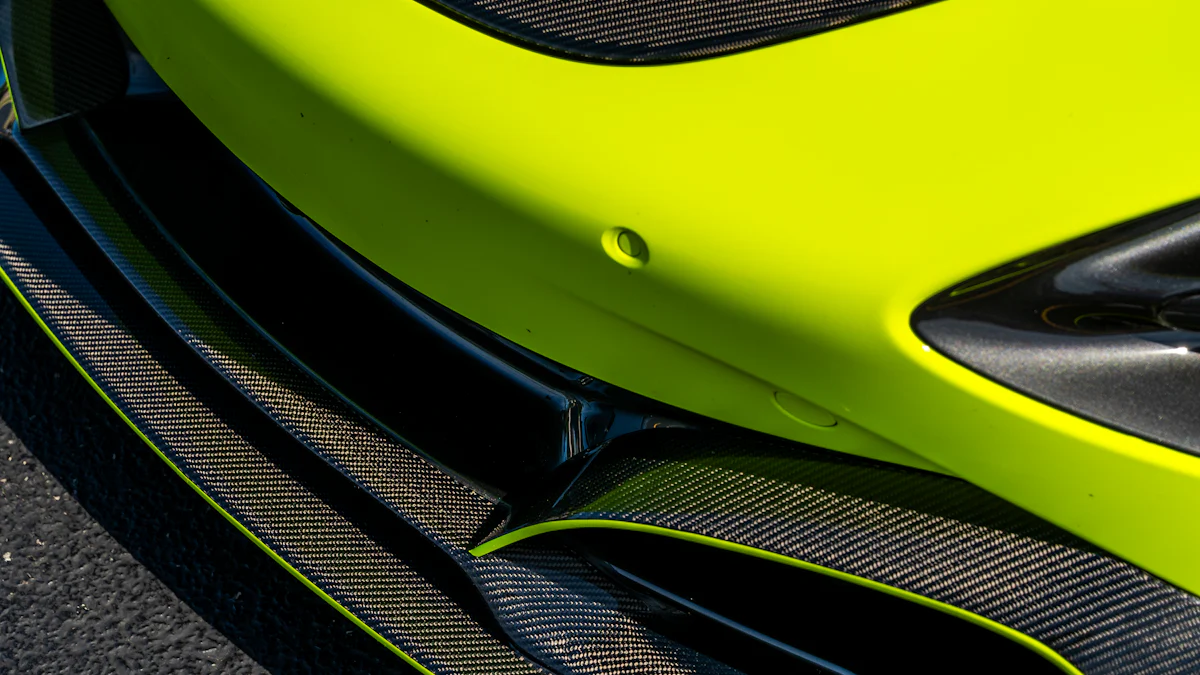Why Real Front Lip Carbon Fiber Matters

Real carbon fiber stands out as a game-changer in automotive design. Its lightweight structure and exceptional strength make it the ideal material for performance parts like front lips. Unlike fake alternatives, which often rely on cheap materials and lack durability, real carbon fiber delivers unmatched functionality. It enhances your car’s aerodynamics, improves handling, and adds a sleek, modern aesthetic. Choosing genuine carbon fiber ensures long-term value, as it resists wear and maintains its integrity over time. For car enthusiasts, investing in authentic front lip carbon fiber elevates both performance and style.
Key Takeaways
Real carbon fiber enhances your vehicle’s performance by reducing weight, improving aerodynamics, and increasing handling stability.
Investing in genuine carbon fiber ensures superior durability, resisting wear and tear even under extreme conditions, unlike fake alternatives.
The unique weave pattern and holographic effect of real carbon fiber provide a premium aesthetic that elevates your car’s style.
While real carbon fiber may come with a higher price tag, it offers long-term value and reliability, reducing the need for frequent replacements.
To identify authentic carbon fiber, check for a consistent weave pattern, perform a weight test, and consider the manufacturer’s reputation.
Choosing real carbon fiber reflects a commitment to quality and authenticity, enhancing both the functionality and appearance of your vehicle.
Key Differences Between Real and Fake Front Lip Carbon Fiber

Material Composition
The composition of a material determines its performance and durability. Real carbon fiber is crafted from carbon atoms bonded in a crystalline structure. This process creates a material that is both lightweight and incredibly strong. Manufacturers weave these carbon threads into a distinct pattern, giving real carbon fiber its signature look and resilience. In contrast, fake carbon fiber relies on cheaper substitutes like vinyl, ABS plastic, or fiberglass. These materials mimic the appearance of carbon fiber but lack its structural integrity. While real carbon fiber materials excel in high-performance applications, fake alternatives often fail under stress, making them unsuitable for demanding automotive uses.
Weight and Strength
Weight and strength are critical factors for automotive parts. Real carbon fiber stands out due to its lightweight properties and exceptional strength-to-weight ratio. This makes it ideal for front lips, where reducing weight improves aerodynamics and handling. Fake carbon fiber, often made from denser materials like plastic or fiberglass, adds unnecessary weight to your vehicle. Additionally, fake materials lack the robustness of real carbon fiber, making them prone to bending or cracking under pressure. Choosing real carbon fiber ensures you get a durable and efficient component that enhances your car’s performance.
Appearance and Finish
The visual appeal of carbon fiber parts plays a significant role in their popularity. Real carbon fiber features a unique weave pattern with a three-dimensional effect. When light interacts with it, the material produces a captivating holographic effect that enhances your car’s aesthetics. Fake carbon fiber, however, often falls short in appearance. Many fake products use printed or painted patterns that lack depth and realism. Over time, these imitations may fade, peel, or lose their luster, diminishing your vehicle’s overall look. Opting for real carbon fiber ensures a premium finish that maintains its elegance for years.
Cost
The cost of real carbon fiber often reflects its superior quality and performance. Genuine carbon fiber requires an intricate manufacturing process, involving the weaving of carbon threads into a crystalline structure. This process ensures exceptional strength, durability, and a premium finish. As a result, real carbon fiber front lips typically come with a higher price tag. However, this investment pays off in the long run by delivering unmatched performance and longevity.
Fake carbon fiber, on the other hand, is significantly cheaper. Manufacturers use materials like ABS plastic, vinyl, or fiberglass to mimic the appearance of real carbon fiber. These materials reduce production costs but compromise quality. While the lower price may seem appealing, fake carbon fiber often fails to provide the durability and functionality needed for high-performance automotive parts. Over time, you may end up spending more on replacements or repairs.
When evaluating cost, consider the value you receive. Real carbon fiber offers a combination of lightweight design, strength, and aesthetic appeal that fake alternatives cannot match. By choosing authentic materials, you ensure a worthwhile investment that enhances your vehicle’s performance and style.
Benefits of Real Carbon Fiber Front Lips

Enhanced Performance
Real carbon fiber front lips significantly improve your car’s performance. Their lightweight structure reduces the overall weight of your vehicle, which enhances acceleration and handling. By optimizing aerodynamics, these carbon fiber parts help reduce drag and increase downforce, ensuring better stability at high speeds. Unlike fake alternatives, real carbon fiber maintains its structural integrity under stress, making it ideal for performance-driven automotive applications. Whether you’re navigating sharp corners or cruising on highways, a genuine front lip carbon fiber ensures a smoother and more controlled driving experience.
Superior Durability
Durability is a key factor when choosing carbon fiber accessories for your car. Real carbon fiber excels in this area due to its robust nature. The material resists wear, cracking, and peeling, even under extreme conditions. This makes it a reliable choice for front lips, which often face exposure to road debris, weather changes, and high-speed impacts. Fake carbon fiber, typically made from materials like ABS plastic or fiberglass, lacks this resilience. Over time, these imitations may warp, crack, or lose their functionality. By investing in real carbon fiber, you ensure that your front lip remains intact and effective for years.
Premium Aesthetics
The visual appeal of real carbon fiber accessories sets them apart. A genuine front lip carbon fiber features a distinctive weave pattern that creates a three-dimensional effect. When light hits the surface, it produces a striking holographic appearance that enhances your car’s overall look. This premium aesthetic is unmatched by fake carbon fiber, which often relies on printed patterns that fade or peel over time. For owners of high-end vehicles like Tesla, carbon fiber parts add a touch of sophistication and exclusivity. Choosing real carbon fiber not only elevates your car’s style but also reflects your commitment to quality and authenticity.
Drawbacks of Fake Carbon Fiber Front Lips
Poor Performance
Fake carbon fiber parts fail to deliver the performance you expect from high-quality automotive components. These parts often use materials like ABS plastic or fiberglass, which lack the strength and rigidity of real carbon fiber. When subjected to stress, fake carbon fiber front lips may bend, crack, or even detach, compromising your car’s aerodynamics and stability. Unlike genuine carbon fiber, which enhances handling and reduces drag, fake alternatives can negatively impact your driving experience. Poor performance not only diminishes your vehicle’s functionality but also poses safety risks, especially at high speeds or during sharp maneuvers.
Shorter Lifespan
Durability is a critical factor for any car accessory, and fake carbon fiber front lips fall short in this area. The materials used in these imitations are prone to wear and tear, making them unsuitable for long-term use. Exposure to road debris, UV rays, and temperature fluctuations often leads to warping, fading, or peeling. Over time, these parts lose their structural integrity, requiring frequent replacements. Real carbon fiber, on the other hand, is designed to withstand harsh conditions and maintain its performance for years. By choosing fake carbon fiber, you risk spending more on repairs and replacements in the long run.
Deceptive Appearance
At first glance, fake carbon fiber may look similar to the real thing, but closer inspection reveals significant differences. Genuine carbon fiber features a distinct weave pattern and a holographic effect when light hits its surface. Fake carbon fiber parts, however, rely on printed or painted patterns that lack depth and realism. Over time, these imitations often fade or peel, leaving your car with an unappealing and cheap look. For car enthusiasts who value authenticity and style, the deceptive appearance of fake carbon fiber can be a major disappointment. Investing in real carbon fiber ensures your vehicle maintains its premium aesthetic and reflects your commitment to quality.
How to Identify Real Carbon Fiber Front Lips
Check the Weave Pattern
The weave pattern is one of the most reliable indicators of real carbon fiber. Genuine carbon fiber features a distinct and uniform weave that creates a three-dimensional effect. The pattern appears consistent, with no irregularities or distortions. When light hits the surface, it produces a holographic effect that enhances its premium look. Fake carbon fiber often uses printed or painted patterns that lack depth and realism. These imitations may show uneven designs or misaligned weaves, which can be easily spotted upon closer inspection. By carefully examining the weave, you can identify whether the material is authentic or a cheap imitation.
Perform a Weight Test
Weight plays a crucial role in distinguishing real carbon fiber from fake alternatives. Genuine carbon fiber is known for its lightweight properties, which contribute to improved vehicle performance and handling. When you hold a real carbon fiber part, it feels surprisingly light despite its strength. In contrast, fake carbon fiber parts, often made from materials like ABS plastic or fiberglass, are significantly heavier. These materials compromise the weight advantage that real carbon fiber offers. Performing a simple weight test can help you determine the authenticity of the material. If the part feels heavier than expected, it is likely not genuine carbon fiber.
Inspect the Price
The price of carbon fiber parts can also provide valuable clues about their authenticity. Real carbon fiber requires an intricate manufacturing process, which involves weaving carbon threads into a crystalline structure. This process results in a higher production cost, making genuine carbon fiber parts more expensive. If you come across a front lip advertised at an unusually low price, it is likely a fake. Manufacturers of fake carbon fiber often use cheaper materials like vinyl or fiberglass to reduce costs, but these materials lack the durability and performance of real carbon fiber. While the upfront cost of genuine carbon fiber may be higher, it ensures long-term value and reliability.
Look for Manufacturer Credentials
The manufacturer’s reputation plays a crucial role in determining the authenticity of carbon fiber front lips. Trusted manufacturers often provide detailed information about their production processes, materials, and quality standards. You should prioritize brands with a proven track record of delivering high-performance automotive parts. These companies invest in advanced manufacturing techniques to ensure their products meet the highest standards of strength, durability, and aesthetics.
Reputable manufacturers typically offer certifications or documentation to verify the authenticity of their carbon fiber products. These credentials demonstrate their commitment to quality and transparency. When evaluating a front lip, check for labels, serial numbers, or official branding that confirms it comes from a reliable source. Avoid products from unknown or unverified manufacturers, as they often use cheaper materials like ABS plastic or fiberglass to mimic the appearance of real carbon fiber.
You can also research customer reviews and testimonials to gauge the reliability of a manufacturer. Positive feedback from other car enthusiasts often indicates a trustworthy brand. On the other hand, complaints about poor performance, durability issues, or deceptive marketing may signal that the manufacturer produces fake or substandard parts. By choosing a reputable manufacturer, you reduce the risk of purchasing fake carbon fiber and ensure your front lip delivers the performance and longevity you expect.
Real carbon fiber front lips deliver exceptional performance, durability, and style. They enhance your vehicle’s aerodynamics and handling while maintaining a sleek, premium appearance. Fake carbon fiber may seem cost-effective initially, but its inferior materials often lead to poor performance and frequent replacements. To ensure you’re investing in authentic carbon fiber parts, evaluate the weave pattern, weight, price, and manufacturer credentials. By choosing real carbon fiber, you not only improve your car’s functionality but also add long-term value and reliability to your investment.
FAQ
What makes real carbon fiber better than fake alternatives?
Real carbon fiber offers superior strength, lightweight properties, and durability. It enhances your car’s performance by improving aerodynamics and handling. Fake carbon fiber, often made from materials like ABS plastic or fiberglass, lacks these qualities. It may look similar but fails to deliver the same level of functionality and longevity.
How can you tell if a front lip carbon fiber is real?
You can identify real carbon fiber by examining its weave pattern, weight, and price. Genuine carbon fiber has a consistent, three-dimensional weave that creates a holographic effect under light. It feels lightweight yet sturdy. Additionally, real carbon fiber typically costs more due to its intricate manufacturing process. Always check for manufacturer credentials to ensure authenticity.
Why is real carbon fiber more expensive?
The production of real carbon fiber involves weaving carbon threads into a crystalline structure. This process requires advanced technology and skilled craftsmanship, which increases the cost. The higher price reflects the material’s exceptional strength, durability, and premium finish. While fake carbon fiber is cheaper, it compromises on quality and performance.
Does using real carbon fiber improve vehicle performance?
Yes, real carbon fiber significantly enhances vehicle performance. Its lightweight structure reduces overall weight, improving acceleration and handling. It also optimizes aerodynamics by reducing drag and increasing downforce. These benefits make real carbon fiber an ideal choice for performance-driven automotive parts like front lips.
Can fake carbon fiber damage your car?
Fake carbon fiber can negatively impact your car. Its inferior materials lack the strength and rigidity of real carbon fiber, making it prone to bending, cracking, or detaching. These issues can compromise your car’s aerodynamics and stability, especially at high speeds. Over time, fake carbon fiber may also warp or peel, leading to additional repair costs.
How long does a real carbon fiber front lip last?
A real carbon fiber front lip can last for years with proper care. Its robust nature resists wear, cracking, and peeling, even under harsh conditions. Unlike fake alternatives, real carbon fiber maintains its structural integrity and appearance over time, making it a reliable and long-lasting investment.
Are there trusted manufacturers for carbon fiber parts?
Yes, many reputable manufacturers specialize in high-quality carbon fiber parts. Companies like Top Carbon Fiber Manufacturing Companies produce a range of products, including Carbon Fiber Front Lip, Carbon Fiber Car Rear Lip, and Carbon Fiber Car Spoiler. Always choose brands with a proven track record and positive customer reviews to ensure authenticity and quality.
Is it worth investing in real carbon fiber for aesthetic purposes?
Absolutely. Real carbon fiber offers a premium aesthetic with its unique weave pattern and holographic effect. It adds a sleek, modern look to your car that fake carbon fiber cannot replicate. For high-end vehicles, real carbon fiber enhances both style and exclusivity, making it a worthwhile investment.
How do you maintain a real carbon fiber front lip?
Maintaining a real carbon fiber front lip is simple. Clean it regularly with a soft cloth and mild soap to remove dirt and debris. Avoid abrasive cleaners that could damage the surface. Applying a UV protectant can help preserve its finish and prevent fading over time. Proper care ensures your front lip remains in excellent condition for years.
Can fake carbon fiber be upgraded to real carbon fiber?
Yes, you can replace fake carbon fiber parts with real ones. Start by identifying trusted manufacturers or suppliers of genuine carbon fiber products. Ensure the new part fits your vehicle model and meets your performance needs. Upgrading to real carbon fiber improves your car’s functionality, durability, and appearance.
